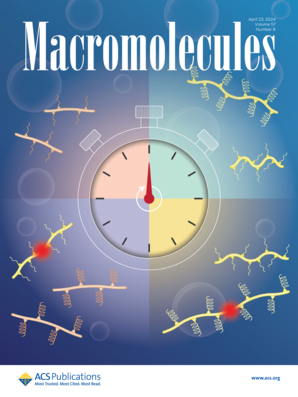Exceptionally High Melting Temperature of Polymer Crystal with Fully Extended Chains Prepared via Topochemical Polymerization and Its Analysis Based on Nonlinear Modified Hoffman–Weeks Approach
IF 5.1
1区 化学
Q1 POLYMER SCIENCE
引用次数: 0
Abstract
One of the important parameters characterizing semicrystalline polymers is the melting temperature, which is linked to the lamellar thickness. However, within reasonable experimental time scales, the range of achievable lamellar thicknesses is limited, which makes the validation of theory difficult. Herein, we prepared polymer crystals of polymuconate with fully extended chains via topochemical polymerization. The melting temperature of the as-prepared polymer was found to be 217 °C. In contrast, the same polymer exhibited melting temperatures ranging from 148 to 156 °C after crystallization from the melt at various crystallization temperatures within the accessible experimental range. This extremely large difference in melting temperature cannot be explained by linear extrapolation of the Hoffmann–Weeks plot. We show that the experimental data can be described by the nonlinear Hoffmann–Weeks approach and discuss the applicability of the nonlinear Hoffmann–Weeks approach.

拓扑化学聚合法制备全延伸链聚合物晶体的超高熔融温度及其基于非线性修正Hoffman-Weeks法的分析
表征半晶聚合物的一个重要参数是熔融温度,它与层厚有关。然而,在合理的实验时间尺度内,可实现的片层厚度范围是有限的,这给理论的验证带来了困难。在此,我们通过拓扑化学聚合制备了具有完全延伸链的多磺酸盐聚合物晶体。所得聚合物的熔融温度为217 ℃。相比之下,相同的聚合物在不同的结晶温度下结晶后,在可达到的实验范围内,熔体的熔融温度为148 ~ 156 ℃。这种巨大的熔化温度差异不能用霍夫曼-威克斯图的线性外推来解释。我们证明了实验数据可以用非线性Hoffmann-Weeks方法来描述,并讨论了非线性Hoffmann-Weeks方法的适用性。
本文章由计算机程序翻译,如有差异,请以英文原文为准。
求助全文
约1分钟内获得全文
求助全文
来源期刊

Macromolecules
工程技术-高分子科学
CiteScore
9.30
自引率
16.40%
发文量
942
审稿时长
2 months
期刊介绍:
Macromolecules publishes original, fundamental, and impactful research on all aspects of polymer science. Topics of interest include synthesis (e.g., controlled polymerizations, polymerization catalysis, post polymerization modification, new monomer structures and polymer architectures, and polymerization mechanisms/kinetics analysis); phase behavior, thermodynamics, dynamic, and ordering/disordering phenomena (e.g., self-assembly, gelation, crystallization, solution/melt/solid-state characteristics); structure and properties (e.g., mechanical and rheological properties, surface/interfacial characteristics, electronic and transport properties); new state of the art characterization (e.g., spectroscopy, scattering, microscopy, rheology), simulation (e.g., Monte Carlo, molecular dynamics, multi-scale/coarse-grained modeling), and theoretical methods. Renewable/sustainable polymers, polymer networks, responsive polymers, electro-, magneto- and opto-active macromolecules, inorganic polymers, charge-transporting polymers (ion-containing, semiconducting, and conducting), nanostructured polymers, and polymer composites are also of interest. Typical papers published in Macromolecules showcase important and innovative concepts, experimental methods/observations, and theoretical/computational approaches that demonstrate a fundamental advance in the understanding of polymers.
 求助内容:
求助内容: 应助结果提醒方式:
应助结果提醒方式:


